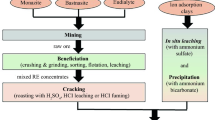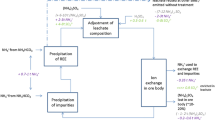Abstract
Purpose
Rare earth elements (REEs) are among the most critical raw materials with a high supply risk. Despite their criticality, REEs are not covered by any resource Life Cycle Impact Assessment (LCIA) methods. The main purpose of the current study is to tackle the issue of missing characterization factors (CFs) for REEs in Life Cycle Assessment (LCA).
Methods
The development of resource depletion characterization factors for REEs in this study are based on two widely used resource assessment methods, Abiotic Depletion Potential (ADP) and ReCiPe. ADP is based on the use-to-stock ratio, while ReCiPe focuses on the additional cost that society has to pay as a result of extraction. To develop the CFs, a wide range of data is gathered from USGS archives and specific mining reports for 11 large deposits worldwide.
Results and discussion
The characterization factors for 15 REEs, following the ADP and ReCiPe, are provided in this article. A comparison of the developed CFs with other resources confirms their compatibility. All REE CFs, except ADP for dysprosium (among the 25% highest CFs), are placed among the highest 50 to 75% available CFs for both methods. The significant difference between the results, whether including REE CFs or not, highlights the possible misinterpretation of LCA results.
Conclusions
The results reveal that REEs have a relatively high resource impact; therefore, they should be included in the assessment of resources. In addition, applicability of the provided CFs is checked in a NdFeB permanent magnets case study, and some recommendations are provided for the practice. The proposed CFs can be used for both the further update of methods and readily implementation in main LCA software, such as Simapro and GaBi, to address the resource depletion of REEs.




Similar content being viewed by others
Notes
Pm and Sc are not included in this study, because Pm has no stable isotopes, and Sc is rarely available in the global trade of pure metals. Total transport of about 50 kg per year.
Compared to the set of factors, Guinée and Heijungs (1995), some elements are missed in the updated version (2002): actinium, argon, cerium, cesium, dysprosium, erbium, europium, gadolinium, hafnium, holmium, krypton, lanthanum, lutetium, neodymium, neon, polonium, praseodymium, protactinium, radium, radon, rubidium, samarium, scandium, therbium, thorium, thulium, xenon and ytterbium (Van Oers et al. 2002).
References
Adibi N, Lafhaj Z, Gemechu ED, Sonnemann G, Payet J (2014) Introducing a multi-criteria indicator to better evaluate impacts of rare earth materials production and consumption in life cycle assessment. J Rare Earths 32:288–292
Adibi N, Lafhaj Z, Yehya M, Payet J (2017) Global resource indicator for life cycle impact assessment: applied in wind turbine case study. J Clean Prod 165:1517–1528. https://doi.org/10.1016/j.jclepro.2017.07.226
Alonso E, Sherman AM, Wallington TJ, Everson MP, Field FR, Roth R, Kirchain RE (2012) Evaluating rare earth element availability: a case with revolutionary demand from clean technologies. Environ Sci Technol 46:3406–3414
Binnemans K, Jones PT (2015) Rare earths and the balance problem. J Sustain Metall 1:29–38
Binnemans K, Jones PT, Blanpain B, van Gerven T, Yang Y, Walton A, Buchert M (2013) Recycling of rare earths: a critical review. J Clean Prod 51:1–22
CRIRSCO (2006) International reporting template for the reporting of exploration results. Mineral Res Mineral Reserves:1–41
Dobransky S (2015) The curious disjunction of rare earth elements and US politics: analyzing the inability to develop a secure REE supply chain. pp 85–105. doi: https://doi.org/10.1057/9781137364241_5
Drielsma J, Allington R, Brady T, Guinée J, Hammarstrom J, Hummen T, Russell-Vaccari A, Schneider L, Sonnemann G, Weihed P (2016a) Abiotic raw-materials in life cycle impact assessments: an emerging consensus across disciplines. Resources 5:12. https://doi.org/10.3390/resources5010012
Drielsma JA, Russell-Vaccari AJ, Drnek T, Brady T, Weihed P, Mistry M, Simbor LP (2016b) Mineral resources in life cycle impact assessment—defining the path forward. Int J Life Cycle Assess 21:85–105
European Commission (2010) Critical raw materials for the EU report of the ad-hoc working group on. European Union (2013) PEF OEF methods
Goedkoop M, Heijungs R, Huijbregts M, et al (2009) ReCiPe 2008
Guinée JB, Heijungs R (1995) A proposal for the definition of resource equivalency factors for use in product life-cycle assessment. Environ Toxicol Chem 14:917–925. https://doi.org/10.1002/etc.5620140525
Hauschild MZ, Huijbregts MAJ (eds) (2015) Life Cycle Impact Assessment. Springer Netherlands, Dordrecht
Henßler M, Bach V, Berger M, Finkbeiner M, Ruhland K (2016) Resource efficiency assessment—comparing a plug-in hybrid with a conventional combustion engine. Resources 5:5. https://doi.org/10.3390/resources5010005
JRC European Commission (2011) ILCD Handbook: Recommendations for Life Cycle Impact Assessment in the European context
Klinglmair M, Sala S, Brandão M (2014) Assessing resource depletion in LCA: a review of methods and methodological issues. Int J Life Cycle Assess 19:580–592
Mancini L, Benini L, Sala S (2018) Characterization of raw materials based on supply risk indicators for Europe. Int J Life Cycle Assess 23:726–738
Mark G, Renilde S (2001) The Eco-indicator 99: a damage oriented method for life cycle impact assessment
Schneider L, Berger M, Finkbeiner M (2015) Abiotic resource depletion in LCA—background and update of the anthropogenic stock extended abiotic depletion potential (AADP) model. Int J Life Cycle Assess 20:709–721
Sonnemann G, Gemechu ED, Adibi N, de Bruille V, Bulle C (2015) From a critical review to a conceptual framework for integrating the criticality of resources into life cycle sustainability assessment. J Clean Prod 94:20–34
Stewart M, Weidema B (2005) A consistent framework for assessing the impacts from resource use: a focus on resource functionality. Int J Life Cycle Assess 10:240–247
Sugimoto S (2011) Current status and recent topics of rare-earth permanent magnets. J Phys D Appl Phys 44:64001. https://doi.org/10.1088/0022-3727/44/6/064001
Swart P, Dewulf J (2013) Resources, conservation and recycling quantifying the impacts of primary metal resource use in life cycle assessment based on recent mining data. Resources, Conserv Recycl 73:180–187
USGS (2017) USGS Minerals information. In: Int. Miner. Stat. Inf. http://minerals.usgs.gov/
Van Oers L, Koning A de, Guinée J, Huppes G (2002) Abiotic resource depletion in LCA
Vieira M, Ponsioen T, Goedkoop M, Huijbregts M (2016) Surplus cost potential as a life cycle impact indicator for metal extraction. Resources 5:1–12
Wenzel H, Hauschild MZ (1997) Environmental Assessment of Products: Volume 2: Scientific Background
Zakotnik M, Tudor CO, Peiró LT, Afiuny P, Skomski R, Hatch GP (2016) Analysis of energy usage in Nd–Fe–B magnet to magnet recycling. Environ Technol Innov 5:117–126
Acknowledgements
The authors would like to express sincere acknowledgements to Christian Traisnel and Sierra Adibi for all their valuable feedbacks.
Author information
Authors and Affiliations
Corresponding author
Additional information
Responsible editor: Andrea J. Russell-Vaccari.
Electronic supplementary material
ESM 1
(DOCX 92 kb)
Rights and permissions
About this article
Cite this article
Adibi, N., Lafhaj, Z. & Payet, J. New resource assessment characterization factors for rare earth elements: applied in NdFeB permanent magnet case study. Int J Life Cycle Assess 24, 712–724 (2019). https://doi.org/10.1007/s11367-018-1489-x
Received:
Accepted:
Published:
Issue Date:
DOI: https://doi.org/10.1007/s11367-018-1489-x




